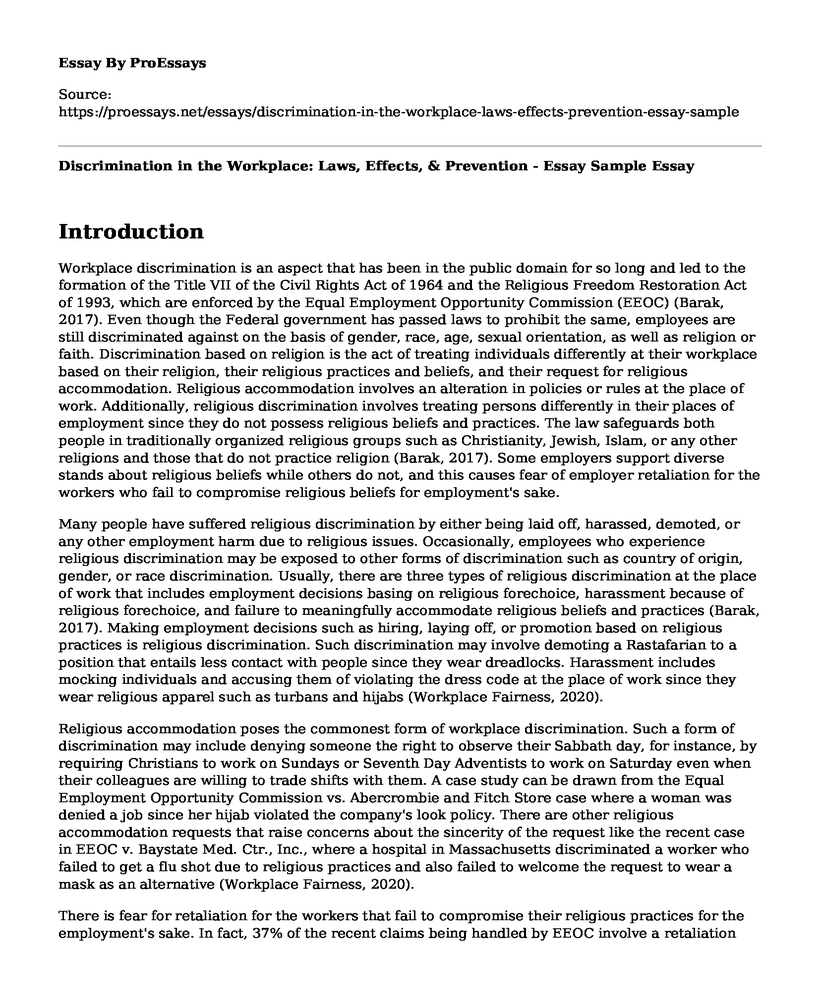Introduction
Workplace discrimination is an aspect that has been in the public domain for so long and led to the formation of the Title VII of the Civil Rights Act of 1964 and the Religious Freedom Restoration Act of 1993, which are enforced by the Equal Employment Opportunity Commission (EEOC) (Barak, 2017). Even though the Federal government has passed laws to prohibit the same, employees are still discriminated against on the basis of gender, race, age, sexual orientation, as well as religion or faith. Discrimination based on religion is the act of treating individuals differently at their workplace based on their religion, their religious practices and beliefs, and their request for religious accommodation. Religious accommodation involves an alteration in policies or rules at the place of work. Additionally, religious discrimination involves treating persons differently in their places of employment since they do not possess religious beliefs and practices. The law safeguards both people in traditionally organized religious groups such as Christianity, Jewish, Islam, or any other religions and those that do not practice religion (Barak, 2017). Some employers support diverse stands about religious beliefs while others do not, and this causes fear of employer retaliation for the workers who fail to compromise religious beliefs for employment's sake.
Many people have suffered religious discrimination by either being laid off, harassed, demoted, or any other employment harm due to religious issues. Occasionally, employees who experience religious discrimination may be exposed to other forms of discrimination such as country of origin, gender, or race discrimination. Usually, there are three types of religious discrimination at the place of work that includes employment decisions basing on religious forechoice, harassment because of religious forechoice, and failure to meaningfully accommodate religious beliefs and practices (Barak, 2017). Making employment decisions such as hiring, laying off, or promotion based on religious practices is religious discrimination. Such discrimination may involve demoting a Rastafarian to a position that entails less contact with people since they wear dreadlocks. Harassment includes mocking individuals and accusing them of violating the dress code at the place of work since they wear religious apparel such as turbans and hijabs (Workplace Fairness, 2020).
Religious accommodation poses the commonest form of workplace discrimination. Such a form of discrimination may include denying someone the right to observe their Sabbath day, for instance, by requiring Christians to work on Sundays or Seventh Day Adventists to work on Saturday even when their colleagues are willing to trade shifts with them. A case study can be drawn from the Equal Employment Opportunity Commission vs. Abercrombie and Fitch Store case where a woman was denied a job since her hijab violated the company's look policy. There are other religious accommodation requests that raise concerns about the sincerity of the request like the recent case in EEOC v. Baystate Med. Ctr., Inc., where a hospital in Massachusetts discriminated a worker who failed to get a flu shot due to religious practices and also failed to welcome the request to wear a mask as an alternative (Workplace Fairness, 2020).
There is fear for retaliation for the workers that fail to compromise their religious practices for the employment's sake. In fact, 37% of the recent claims being handled by EEOC involve a retaliation charge, with the number being said to increase due to the Supreme Court ruling of 2006 that broaden retaliation as observed in the Burlington Northern & Santa Fe (BNSF) Railway Co. v. White, 548 U.S. 53 (2006). The case saw the revision of retaliation against sexual harassment to involve any adverse employment decisions and treatment which would dissuade a meaningful employee from creating or supporting a charge of discrimination. Religious discrimination has increased in recent times, that is from 1997 to 2015 by 41%, while payouts have heightened by 174% (Workplace Fairness, 2020).
References
Barak, M. E. M. (2017). Managing diversity: Toward a globally inclusive workplace. (Fourth Ed). Thousand Oaks, CA: Sage. ISBN 978-1483386126. https://cloudmega.gq/?books2&pid=10007466&m=Top10000
Workplace Fairness. (2020). Religious discrimination. https://www.workplacefairness.org/religious-discrimination#:~:text=Religious%20discrimination%20is%20treating%20individuals,their%20religious%20beliefs%20and%20practices.
Cite this page
Discrimination in the Workplace: Laws, Effects, & Prevention - Essay Sample. (2023, Aug 25). Retrieved from https://proessays.net/essays/discrimination-in-the-workplace-laws-effects-prevention-essay-sample
If you are the original author of this essay and no longer wish to have it published on the ProEssays website, please click below to request its removal:
- The Brexit Deal and Its Implications on Immigrations and Borders Essay
- Essay Sample on Body Image & Photo Manipulation: Understanding Society's Standards
- Essay Example on Human Trafficking: Karla Jacinto's Case & Controls Needed
- Essay Example on Elvira's Story: An Immigrant's Journey for a Better Life
- Essay Example on Gender Roles in Religion: Women in Leadership?
- Essay Sample on Old Age: Access to Quality Healthcare Services
- Free Essay on 100 Years Since Women Gained Right to Vote: Imagining a World Without It







